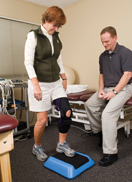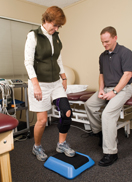| | Much has been written about disability management, but little has changed. In private disability insurance, so-called "mental/nervous" claims, mostly depression, have become the prime cause of long-term disability. For Workers' Compensation plans, musculoskeletal disorders (MSDs) are the most common claim and, Ontario accounts for over 40% of all lost-time claims and claim costs, and half of all lost-time days. MSDs are defined as both injuries and disorders that develop over time, and are "strongly linked" to workplace hazards and risk factors. This term includes back pain, repetitive strain injuries, acute sprains and strains, overuse (e.g., carpal tunnel syndrome), and cumulative trauma injuries. Facts and Impressions In 2006, 980,265 Workers' Compensation claims were reported across Canada, including 318,286 lost-time injuries. There were 955 deaths on the job.1 Only lost-time injury claims declined from one and five years earlier.2 At the end of 2006, 9.6 million Canadians enjoyed some form of insured disability income insurance, with 1.1 million more having non-insured disability income protection.3 One published study used focus groups to collect the views of 58 males and females between ages 16 and 18 regarding work injury. Generally, minor injuries were seen as "part of the job", and they believed their managers took no serious interest in safety. Girls said their concerns were usually disregarded, and boys did not complain in order to appear "mature".4 Seven Principles of Successful Return to Work5 These seven factors affect the key outcomes of cost and duration of work disability, and quality of life for injured workers. - Strong commitment to health and safety that is demonstrated by the workplace parties (employer, union, employee, co-workers).
- Appropriate offers of modified work are made to facilitate early and safe return to work (RTW).
- Someone is responsible to ensure the RTW plan supports the returning worker without disadvantaging and creating resentment among co-workers and supervisors.
- Supervisors are trained in communication and preventing workplace injuries and illnesses, and they are part of the RTW process.
- The employer, ideally the direct supervisor, makes early contact with the absent employee, focusing on the employee's well-being, and not the cost or cause of the absence.
- A person has specific responsibility to coordinate RTW. That role may be either internal or external, and will focus on planning, communication, and creating reasonable expectations.
- There is appropriate contact between the employer and health care providers about readiness to return, accommodation, or job demands, with the absent employee's consent.
Best Practices The Workers' Compensation Board of Manitoba6 asked employers why they had invested the necessary time and energy to create and maintain a 'safety culture'. The response noted financial benefits such as reduced WCB assessments, less overtime, and more efficient production, as well as reinforcing the organization's commitment to and concern for its employees. Key components suggested by the Manitoba employer group and complementary to those noted above are: - Communications about safety and disability management are regular, ongoing, effective, and are targeted to everyone in the organization.
- Education and training about safety and disability management are mandatory and continuous for all staff.
- Processes are developed to control the risk of accidents.
- Accidents and near-misses are investigated immediately, focusing on cause and effect, and prevention. Statistics are compiled and analysed to identify trends and problem areas.
In addition, there are more subjective (qualitative) issues that influence return to work:7 - Goodwill, confidence and trust between the parties, because the needs of each are understood and respected.
- High probability of miscommunication and misunderstanding, because employees face significant challenges in navigating the rules, conventions, and language of the health and insurance systems, particularly at a time when they are most vulnerable.
Sources: - The 2006 figure excludes NL and the Yukon, where 27 people died on the job in 2005. For comparison, figures from 2005 and 2001 have been adjusted accordingly.
- Association of Workers' Compensation Boards of Canada. Available at: www.awcbc.org.
- Canadian Life and Health Insurance Association, 2007. Key Statistics. Available at: www.clhia.ca.
- Summary of: Breslin FC, Polzer J, et al., 2007. Work injury or "part of the job"?: Towards a gendered understanding of injuries and complaints among younger workers. Social Science & Medicine 64(4): 782-793. Summary available online at: www.iwh.on.ca.
Workers' Compensation Board of Manitoba, undated. Safe Work is Good for Business. Available through WCB Communications Department (204-954-4760). Institute for Work and Health, 2004. Workplace-based Return to Work Interventions: A Systematic Review of the Quantitative and Qualitative Literature, Summary. Available at: www.iwh.on.ca/SR/pdf/IWH_rtw.pdf.
|


